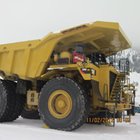New life and a bright future at the Huckleberry Mine

1 of 5The owners of the Huckleberry Mine southwest of Houston, B.C., are in the early stages of considering operating the mine beyond its new 2021 clo
1 of 5The owners of the Huckleberry Mine southwest of Houston, B.C., are in the early stages of considering operating the mine beyond its new 2021 closure date. — Photo courtesy Huckleberry Mines Ltd.
A prominent official with Huckleberry Mines Ltd. said the company is mulling over operating an open-pit copper and molybdenum mine located in west central British Columbia beyond its new 2021 mine-life extension.
Randall Thompson, Huckleberry Mines' general manager and vice-president of operations, said the company is looking into the feasibility of continuing to operate the Huckleberry Mine past its recent seven-year life extension. Huckleberry Mines Ltd. owns Huckleberry Mine, located 123 kilometres southwest of Houston, but is 50 per cent owned by Vancouver-based Imperial Metals Corporation and 50 per cent owned by a consortium of four Japanese companies.
The mine also produces some silver and gold.
Imperial Metals announced the extension of the mine's life on January 3, and this is something that is strongly supported by area First Nations and communities, Thompson said. The extension will preserve 230 full-time jobs and 30 contract positions on site, and will add 70 new jobs.
But Thompson said Huckleberry Mines Ltd. is in the "development stages" of examining whether it can continue mine operations past 2021.
"We're doing that so we can evaluate life beyond 10 years," he said. "And we want to start that now."
However, physical expansion of the mine beyond 2021 isn't the primary issue for Huckleberry Mines at present.
"We want to focus on exploration and what the potential is," Thompson said.
Certainly Thompson has lots to do just in terms of dealing with the ramifications of the newly announced mine-life extension. Huckleberry Mines Ltd. will be spending $119 million on new acquisitions and $82 million on dam construction, on top of the $254.4 million it plans to spend on wages and benefits (excluding contractors).
Construction of the dam, also known as the tailings management facility, is the crux of the reason for the expansion, Thompson said. The company needed a place to store additional waste rock if it was going to continue producing more ore.
It therefore applied to the B.C. government for an amendment to the mine's existing permit to allow for the larger tailings management facility, which was approved in December.
"The resource is there in terms of copper and molybdenum," Thompson said. "The only bottleneck was having that tailings management facility, which we sought an amended permit for. And with current market conditions, it was absolutely feasible to extend the mine."
Construction on the initial dam is expected to start in May and continue for 18 to 24 months. The tailings management facility will store mined waste rock from an older pit along with new mill tailings resulting from the mine extension. Money for the dam will also be used to upgrade it during the mine's life.
Approximately $25 million of the money slated for new acquisitions will be used to buy new equipment, Thompson said. That includes purchasing six haul trucks, two bulldozers, one mining surface drill, two maintenance graders and an excavator, among other items.
Some of the rest of the money will be used to build a new 100-room satellite camp close to where the mine's existing primary camp is now and close to where the new tailings management facility is to be built. Construction of the new camp is expected to start in April.
More of the $119 million for new acquisitions will be spent on upgrading the mine's communications with Internet and phone service, Thompson said. And although no other money is planned for major infrastructure construction, money will be used for upgrades at the mine's SAG mill and two ball mills.
Construction of the new tailings management facility should closely coincide with implementation of the company's new main zone optimization plan. Expansion and stripping of the current pit—both to the southeast and to a lesser extent below the pit—should start this summer, producing a new source of ore.
With implementation of the main zone optimization plan, annual copper production at the mine should average 43.2 million pounds from 2011 to 2019. Production in 2020 to 2021 will be reduced as low-grade stockpiles are milled.
The value of the copper resource to be harvested by implementation of the company's main zone optimization plan is estimated to have a net present value of $150 million. That's based on a price of US$3.40 per pound of copper for 2012 and $3.14 per pound of copper from 2013 to 2021, with the U.S./Canadian exchange rate at par.
The mine has produced a total of 870 million pounds of copper from its inception in 1997 to December 31, 2010. During that time, it also produced eight million pounds of molybdenum, 105,000 ounces of gold and 3.4 million ounces of silver.




